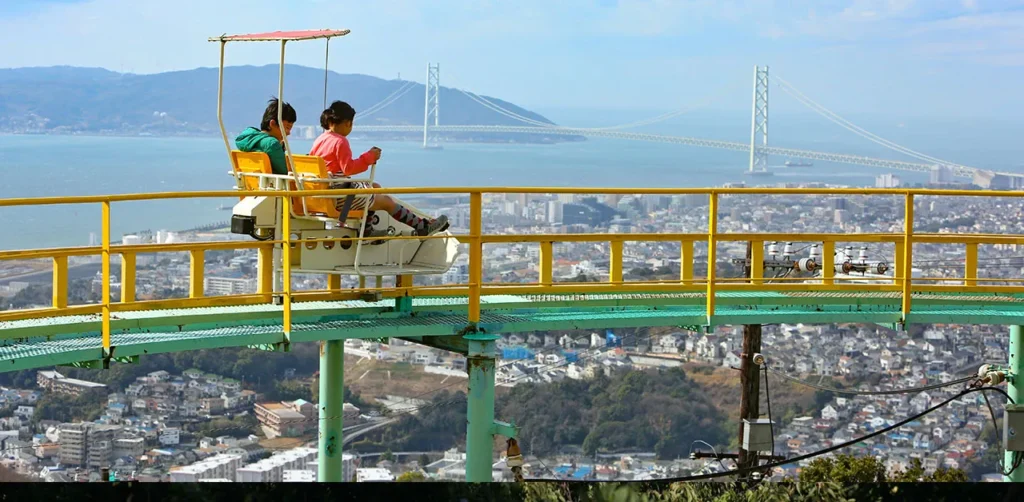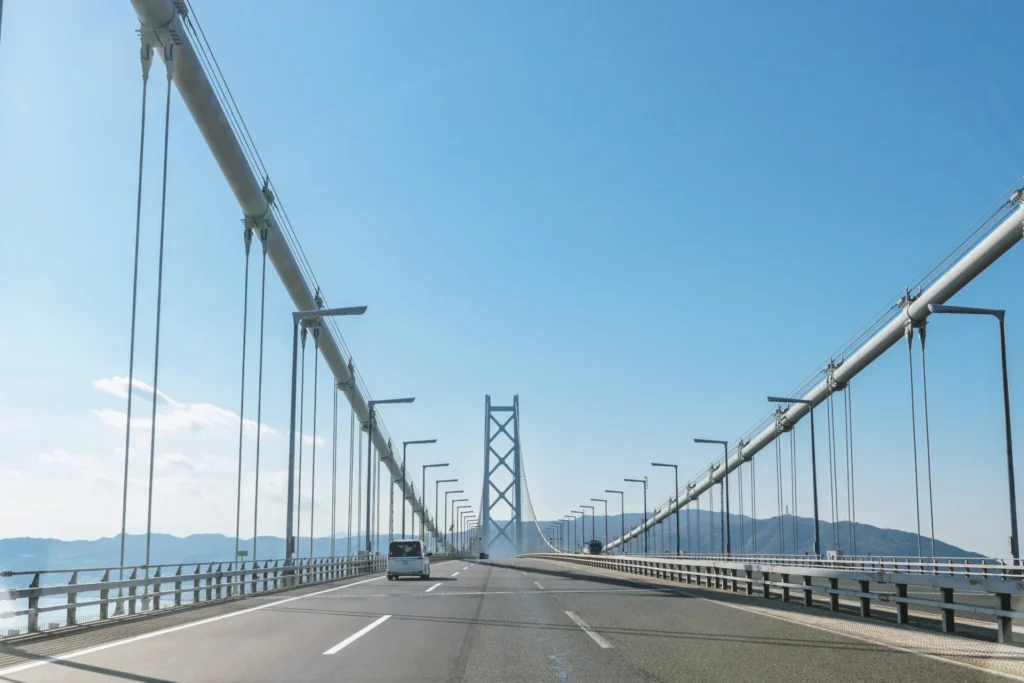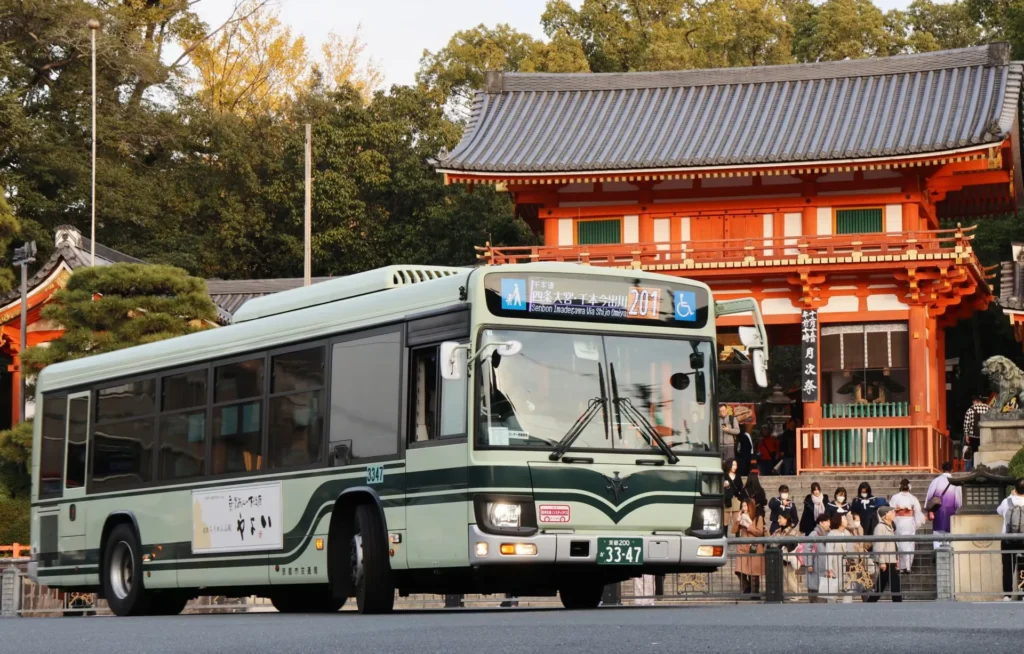神戶
神戶有許多樂趣等待您去體驗與挖掘,包括絕美的海港區、可以欣賞夜景的山脈、充滿異國情調的街道,以及溫泉勝地。
相關文章
-

神戶・須磨浦三條遊樂園|復古遊樂設施、瀨戶內海美景、壯麗櫻花
你聽過神戶的須磨浦三條遊樂園嗎?這個充滿懷舊氣息的遊樂園最近在社群媒體和媒體上人氣飆升。它或許沒有尖端科技或高科技設施,但卻擁有令人懷舊的遊樂設施、刺激的遊樂項目以及其他地方難得一見的絕美景色。在須磨浦三條遊樂園,你可以體驗到彷彿穿越回昭和時代的奇妙感覺。 <目錄> 1. 什麼是須磨浦三條遊樂園? 2. 須磨浦三條遊樂園的交通指南 3. 須磨浦三條遊樂園的優惠門票 4. 遊覽須磨浦三條遊樂園的三大理由:・須磨浦三條遊樂園的特色遊樂設施 ・空中自行車單軌賽道 ・須磨浦三條遊樂園的特色遊樂設施 ・空中自行車單軌航海列車 ・須磨浦三條遊樂園的特色遊樂設施 ・空中自行車單軌 列車 ・可磨浦全景的旋轉咖啡廳“Kissamos 3.三條遊樂園週邊推薦景點須磨浦景點:・神戶須磨海洋世界 ・神戶須磨利休公園 須磨浦三條遊樂園於1959年開業,是一座迷人的復古風格遊樂園,坐落於山頂。遊客可搭乘索道、獨特的「Car-later」自動扶梯和觀光電梯到達山頂。在那裡,您可以體驗到許多充滿懷舊樂趣的項目,包括自行車單軌列車、迷你汽車樂園和兒童遊樂區。公園內設有燒烤區和罕見的旋轉觀景塔,提供豐富多彩的娛樂活動。從公園可以欣賞到瀨戶內海的平靜景色,以及明石海峽大橋和淡路島的迷人風景。前往須磨浦三條遊樂園可搭乘火車。 〇從大阪/神戶三宮出發:從阪神鐵道大阪梅田站搭乘開往姬路的特快列車至山陽須磨站,然後換乘普通列車在須磨浦公園站下車。公園入口就在車站外。 〇從明石/姬路出發:從山陽鐵道搭乘開往阪神梅田的特快列車至山陽垂水海站,然後換乘普通列車在須磨浦公園站下車。公園入口就在車站外。從須茂浦公園站出發,您需要搭乘一系列交通工具才能到達山頂的須茂浦三條遊樂園:纜車(約3分鐘)→汽車(約2分20秒)→觀光電梯(約4分15秒)。我們推薦您使用阪神山陽海濱一日通票遊覽須茂浦三條遊樂園。這張便捷實惠的通票允許您在阪神鐵道大阪梅田站/大阪難波站和山陽鐵道山陽姬路站之間無限次乘坐遊樂設施。此外,我們也推薦您在遊樂園內購買「須茂浦三條遊樂園來回優惠票 - A套餐」。這張來回票包含纜車、汽車、觀光電梯以及觀景塔的門票。・成人(國中生以上):2,100日圓 ・兒童(小學生):1,600日圓 *學齡前兒童免費入場。讓我們為您介紹遊覽須茂浦三條遊樂園的三大不容錯過的亮點。前往須茂浦三條遊樂園,您需要換乘三個精彩刺激的遊樂設施。從第一段纜車開始,全程至少需要60分鐘,通常約90分鐘,如果您想放慢腳步,盡情享受,可能需要長達120分鐘。您的旅程從與山陽鐵道須茂浦公園站直接相連的纜車開始,纜車每15分鐘一班。從纜車車窗,您可以欣賞到壯麗的海景和天空景色,以及沿著海岸線行駛的列車。接下來,您將乘坐連接纜車山頂站和公園內山頂的「車廂」(Car-later)。這種在日本其他地方難得一見的遊樂設施,因其籃狀外觀和著名的“顛簸之旅”而備受喜愛。它劇烈搖晃,緩緩攀升約25度的陡坡。憑藉其獨特的角度和震動,這91公尺長的遊樂設施充滿刺激。最後,您可以登上觀光電梯。電梯以舒緩的速度輕柔搖晃,您可以一邊欣賞美景,一邊享受清爽的微風和悠閒的漂浮感,度過一段平靜愉悅的空中漫步。須茂浦三條遊樂園的必玩項目是自行車單軌列車。這項遊樂設施將您帶入一輛雙人腳踏車,沿著離地3-8公尺的軌道行駛,環繞一週。它老少皆宜,票價為每次300日圓。盡情享受獨特的漂浮感和刺激-彷彿在空中滑翔。在晴朗的日子裡,您可以飽覽明石海峽大橋和淡路島的壯麗景色。櫻花盛開的季節,您甚至可以乘坐觀光列車穿越橫跨軌道的櫻花隧道,體驗夢幻般的春日之旅。在須磨浦三條遊樂園裡,您絕對不容錯過的景點是旋轉觀景塔,它就位於觀光電梯的出口處。三樓的Kissa Cosmos是日本少數仍在運作的旋轉餐廳之一。圓形的地板大約55分鐘旋轉一週。您可以一邊品嚐飲品或享用簡餐和甜點,一邊放鬆身心,欣賞360度的全景。強烈推薦蜜 瓜蘇打和奶油蘇打,在夕陽的映照下,它們顯得格外美麗。咖啡館原創設計的杯墊也十分可愛——可愛到您一定會想帶一個回家。園區內設有多個觀景台,每個觀景台都擁有各自獨特的壯麗景色,從360度全景到獨特的周邊景觀視角,應有盡有。 〇 東展望台 位於纜車旁的Car-Lator車站屋頂,這個觀景台可以俯瞰美麗的須磨海岸線。即使等待回程纜車,也能欣賞到如此美景,令人心曠神怡。 〇 旋轉展望台屋頂觀景台 旋轉展望台屋頂的景色令人嘆為觀止,被評為「兵庫縣150個最佳觀景點」之一。在晴朗的日子裡,甚至可以看到關西國際機場。這裡也是元旦觀賞日出的熱門地點。 〇 西展望台 西展望台是觀賞世界最長懸索橋-明石海峽大橋的絕佳地點。附近設有休息區,是享用自備午餐、欣賞美景的理想場所。 〇 從畑利茶屋 (Hatahuri Chaya) 再往望 從須磨浦三條園 (Sumaura Sanjo Yuen) 再往上走一點,畑利茶屋 (Hatahuri Chaya) 也能欣賞到絕美的景色,絕對值得您花上一小段路程。須磨浦公園也是兵庫縣最著名的賞櫻勝地之一。春天,園區內約有 3200 棵櫻花樹競相綻放。您可以拍攝櫻花環繞的海景,也可以乘坐觀光纜車欣賞漫山遍野的粉紅色櫻花——這是須磨浦三條園獨有的體驗。在神戶鬚磨海洋世界 (Kobe Suma Sea World),您可以觀賞到各種海洋生物,包括虎鯨和海豚,這裡還有日本西部唯一的虎鯨表演。虎鯨和海豚表演都充滿活力,精彩刺激,以美麗的鬚磨海灘為背景。虎鯨表演時,強烈的水花可能會濺到觀眾席上,所以如果您想感受震撼的場面,請務必坐在前排。在藍海虎鯨體育場餐廳,您可以一邊用餐一邊欣賞虎鯨,品嚐以兵庫縣當地食材烹製的美味佳餚。這家餐廳非常受歡迎,因此我們建議您在確定旅行日期後儘早預訂。神戶須磨利休公園是一座大型城市公園,建於昔日皇室別墅-向光利休的舊址之上。公園分為西式庭園風格的主庭園和植物園,遊客可在植物園欣賞玫瑰花、鳶尾花、梅花等時令花卉。遊覽神戶須磨利休公園的最佳時間是5月中旬至6月中旬,屆時約有300個品種、4000株玫瑰盛開;以及10月初至11月中旬。秋季紅葉的最佳觀賞期通常在11月中旬至12月初。在此期間,公園會舉辦特別的燈光秀和照明活動,讓您在色彩繽紛的紅葉叢中漫步,享受愜意時光。從大阪出發,只需約40分鐘車程即可抵達神戶須磨地區,交通十分便利。若想遠離都市的喧囂,何不前往這座充滿復古情調、自然風光旖旎的遊樂園呢?這裡有各種充滿魅力的遊樂設施和景點,讓您盡情釋放童心;周圍環繞著鬱鬱蔥蔥的如茵和蔚藍的大海,定會讓您身心煥然一新。
-

淡路島交通指南:從大阪、神戶和明石出發
兵庫縣的淡路島擁有眾多景點,從風景優美的觀景點和美味的當地美食,到“二次元之森”和“淡路夢舞台”等熱門景點,以及“快樂煎餅”等海濱咖啡館,應有盡有。從大阪或神戶出發,一日遊即可輕鬆抵達。您也可以從關西地區的多個地點租車自駕前往,但本文將介紹如何搭乘大眾運輸工具前往。我們將重點介紹從大阪和神戶前往淡路島的交通方式,特別是高速巴士,並提供行程時間和票價資訊。 <目錄> 1. 從大阪難波前往淡路島 2. 從大阪梅田前往淡路島 3. 從神戶三宮前往淡路島 4. 從明石乘坐渡輪前往淡路島 5. 前往淡路島的要點 從難波前往淡路島有兩種方式:乘坐直達高速巴士或換乘火車和巴士。搭乘巴士:高速巴士可從JR難波站港町巴士總站出發,由西日本JR巴士運營,停靠「二次元之森」站;或從南海難波站出發,由Foot Bus/高鬆快線經高速淡路七號線運營。建議選擇西日本JR巴士,因為其提供多語言預訂頁面。搭乘火車+巴士:從大阪難波站搭乘阪神難波線至舞妓公園站,然後步行約7分鐘至高速舞妓巴士站。根據您的目的地,從那裡乘坐由西日本JR巴士、本市海峽巴士、淡路交通或神姬巴士運營的高速巴士。班次很多,但建議提前透過西日本JR巴士的多語言預訂頁面預訂。從JR難波站港町巴士總站搭乘特快巴士,從南海難波站搭乘特快巴士,從大阪難波站搭乘阪神列車,再從高速舞妓巴士站搭乘特快巴士。發車頻率:每天2班,每小時1班。特快巴士:選擇眾多。票價:成人:1850日圓起;兒童:930日圓起;成人:2630日圓;兒童:半價;成人:火車970日圓+巴士600日圓起;兒童:半價;轉乘:無須;營運時間:上午8:00-9:00;上午6:00-晚上9:00;火車和巴士:上午5:00-晚上11:00。優勢:票價較低。・僅可搭乘巴士直達。・直達二次元之森。・僅可搭乘巴士直達。・班次頻繁,方便安排行程。・行程時間短。・高速舞妓站出發的巴士線和班次豐富,可依最終目的地選擇。缺點:・班次較少。・距離主要旅遊景點(淡路七站)較遠。・需要換乘。 *票價截至2025年11月4日。高速舞妓站有多條高程巴士線。詳情請參閱「高速舞妓巴士總站資訊」。如果您乘坐沿著西海岸行駛的淡路交通或神姬巴士淡路島西海岸線,並在“幸福之鬆餅淡路島度假村前”巴士站下車,即可一邊欣賞美麗的海景,一邊享用蓬鬆的鬆餅。淡路島內有六條由淡路交通巴士營運的路線。選擇合適的線路,有效率地出行。您也可以從大阪/梅田搭乘高速巴士前往淡路島。高速巴士包括西日本JR巴士(從JR大阪站高速巴士總站出發,停靠「二次元之森」)和步行巴士/高鬆快車(從JR大阪站櫻橋出口高架軌道下方出發,停靠「速淡路七」)。其中,推薦搭乘西日本JR巴士,因為它提供多語言預訂服務。從JR大阪站搭乘高速巴士前往高速巴士總站;從JR大阪站前,櫻橋出口高架橋下方搭乘高速巴士;從JR大阪站搭乘JR列車,然後從高速舞妓巴士站搭乘高速巴士。發車頻率:每天2班,每小時1班;高速巴士:多種選擇。票價:成人:1,850日圓起;兒童:930日圓起;兒童:半價;不需換乘;無須換乘;所需時間:約1.5小時(至二次元之森);約2小時(至淡路)。 1小時(至淡路IC/二次元之森)運行時間:9:00、10:00、14:00(具體時間為巴士發車時間) 火車和巴士運行時間:上午6:00至晚上9:00 火車和巴士運行時間:上午5:00至晚上11:00 優勢:・票價較低。・僅可搭乘巴士直達。・直達二次元之森。・僅可搭乘巴士直達。・班次頻繁,方便安排行程。・行程時間較短。・高速舞妓站出發的巴士線和班次選擇多樣,可依最終目的地選擇。 劣勢:・班次較少。・距離主要旅遊景點(淡路七站)較遠。・需要換乘。 *票價截至2025年11月4日。從三宮巴士總站出發,西日本JR巴士、本市海峽巴士和港口觀光巴士營運的高速巴士開往各個目的地。從神姬三宮巴士總站出發,神姬巴士和淡路交通營運的高速巴士也開往不同地區。以下列出部分主要線路。請注意,停靠站點會根據時間和巴士公司而有所不同,因此請務必提前查詢。其中,推薦使用西日本JR巴士,因為它提供多語言預訂服務。三宮~洲本地區 三宮~淡路夢舞台、東浦地區 三宮~南淡路(陸之港正潭、福倉地區) 三宮~西浦地區(五色、高田屋地區) 營運巴士公司及乘車地點(三宮巴士總站):西日本JRR姬巴士、本志海峽巴士(峽谷西河總巴士站) (三宮巴士總站):本子海峽巴士 (姬神三宮巴士總站):姬神巴士、淡路交通 (姬神三宮巴士總站):姬神巴士、淡路交通 班次 數量 每小時 1 至 3 趟 每小時 1 趟 每小時 1 至 2 班次 票價 每小時 1 至 3 趟 每小時 1 趟 每小時 1 至 2 班 票價 大人:780 天大人1,050日圓以上兒童:半價成人:950日圓起 兒童:半價 成人:950日圓起 兒童:半價 主要站點及行程時間 ・二次元之森(約40分鐘) ・大之路世界公園(約1小時20分鐘) ・洲本巴士中心(約130分鐘巴士中心(約130分鐘)・東浦巴士總站(約1小時) ・陸之港素店(約1小時20分鐘) ・淡路IC(約1小時10分鐘) ・陸之港素食店(約1小時20分鐘) ・幸福之煎餅淡路島度假村前(約55分鐘) 濱・尾上之時(約13小時)福1小時40分鐘)・嘉布科斯塔橙子前(約1小時)・伊邪那岐神社前(約1小時10分鐘)・高田屋河平公園(約1小時35分鐘) 運營時間:上午6:00至晚上11:00 上午6:00至晚上11:00 上午6:000至晚上11:00 上午6:00至晚上11:00 上午6:000000000000000 至晚上10000000 上午100000000 *票價截至2025年11月4日。此外,神姬巴士和本市海峽巴士營運北淡路西海岸線,途經淡路縣立公園和全保聖營等目的地。港觀光巴士每天也營運六班高速巴士。這些巴士會在淡路交流道、東浦交流道和洲本交流道等站點停靠,然後繼續前往最終目的地陸之港青丹。對於從明石前往淡路島的旅客,強烈建議搭乘淡路島高速渡輪「淡路傑諾瓦線」。從明石港到淡路島岩屋港的航程僅需約13分鐘,既快速又經濟實惠。途經明石海峽大橋時,您還可以欣賞瀨戶內海的壯麗景色。從JR明石站或山陽明石站步行約10分鐘即可到達明石港。岩屋港碼頭一樓提供電動輔助自行車租借服務,碼頭正前方即巴士站。營運時間:約早上5:00至晚上11:00,每小時1-3班。票價:成人700日圓,兒童350日圓。・高速巴士需提前預約。・即使在同一區域內,巴士站也可能有所不同,請務必事先查看地圖。・一日遊時,建議將大件行李寄存在飯店或車站,以便輕裝出行。 ▼更多詳情▼ 輕鬆出遊 | 大阪梅田站阪急觀光中心提供行李寄放與運送服務。淡路島位於神戶地區,交通便利,從大阪和神戶均可輕鬆抵達,自然風景旖旎。全年氣候溫暖宜人,也是其一大亮點。在關西地區旅行時,不妨安排一天時間前往淡路島。 ▼查看這篇文章▼ 這裡是必去之地!與淡路島自然風景完美融合的絕美建築!
-

大阪、京都和神戶的8大冬季燈光秀!
想知道冬天要去大阪、京都、神戶哪裡觀光嗎?日本各地都會舉辦盛大的燈光秀活動。從關西中心大阪梅田開始,京都和神戶的歷史建築和標誌性建築也將在限定時間內被絢麗的色彩裝點一新。今年,承載著神戶市民祈禱和希望的傳統節日也將回歸。請務必將它列入您的旅行計劃。 ※所有圖片僅供參考。 <大阪>2025大阪燈光節 <大阪梅田>2025梅田藍天大廈聖誕節 <大阪梅田>GRAND FRONT OSAKA“GRAND WISH 2025聖誕節” <大阪梅田>梅北香檳秀梅田<大阪>2025大阪城燈光秀 <京都>2025NAKED meets NIJO-JO CATSLE KANGETSU <神戶>2025神戶聖誕市集 「2025大阪燈光節」是大阪府各地舉辦的大型冬季活動! 「禦堂筋燈光秀 2025」2025年4月9日(週三)~12月31日(週三)禦堂筋燈光秀 2025 將點亮連接梅田、心齋橋和難波的標誌性街道禦堂筋,總長4公里。這條長達約4公里的燈光路徑不僅是日本最長的燈光路徑,還於2015年1月被認定為世界紀錄。 「大阪光之復興 2025」2025年12月14日(週六)~12月25日(週四)大阪光之復興 2025 將在大阪水都的象徵-中之島沿岸呈現一場令人嘆為觀止的燈光秀。作為重要文化財產的大阪市中央公會堂,其令人驚嘆的3D投影LED燈光秀絕對不容錯過! 「區域活動」活動行程因場館和裝置而異,請查看官方網站。地點:禦堂筋地區(阪神十字路口~難波西口十字路口)、大阪市中央公會堂~中之島公園、1970年世博會紀念公園等。日期:2025年11月14日(週五)~12月25日(週四)。梅田著名景點之一的梅田藍天大廈將舉辦一場璀璨奪目的燈光秀。在一樓廣場,一棵約25公尺高的象徵性樹木已經亮相,樹上裝飾著約13萬盞LED燈。今年的主題是「光之馬戲團~夜空中閃耀的奇幻馬戲團~」。白天是光彩奪目的馬戲團,夜晚則是從黑暗中升起的美麗馬戲團。去年大受歡迎的原創馬克杯也是絕佳的紀念品。請查看官方網站 日期:2025年11月6日(週四)~12月25日(週四)*部分地區除外 位於大阪格蘭前線北樓知識廣場的巨型聖誕樹每年都以其迷人的設計令遊客驚嘆不已。今年的聖誕樹名為“無限許願樹”,內外均包裹著鏡面材料,隨著角度和時間的變化,呈現出令人眼花繚亂的視覺效果。站在環繞聖誕樹的三角形裝置前,彷彿置身於萬花筒之中!這裡也是絕佳的拍照地點。燈光秀以黃、紅、藍三色交替變換,更添夢幻氛圍,將整個空間籠罩在迷人的光暈之中。地點:大阪格蘭前線南北館、梅北廣場等。燈光秀:平日16:00~24:00,週末及假日15:00~24:00 *每15分鐘一場(最後一場23:45)。日期:2025年11月6日(週四)~2026年2月28日(週六)。位於JR大阪站北側的「梅北地區」燈光秀不容錯過。除了大阪格蘭前線,新開幕的大阪格蘭綠園和梅北公園的部分區域也裝飾著約25萬盞LED燈。優雅的香檳金色光芒營造出浪漫迷人的氛圍。地點:梅北廣場、大阪梅北公園等。日期:2025年12月1日(週一)~12月25日(週四)。今年是該活動的第六屆,主題為「五顆心,環繞梅田」。主活動「HEART FES」將於12月13日(週六)至12月14日(週日)舉行,為期兩天。活動內容包括聖誕音樂會、工作坊、遊行表演等,遍及梅田的五個區域。此外,「HEART SPOT」活動將聯合梅田47個機構,以「心形」和「燈光」裝飾整個城市。地點:梅田地區。日期:2025年11月1日(週五)~2026年2月1日(週日)。大阪城西之丸庭園將被約350萬盞LED燈點亮,與雄偉的天守閣交相輝映。燈光秀以將軍、武士和頭盔等圖案為主題,展現了大阪從戰國時代至今的歷史。它以令人嘆為觀止的規模,將戰國時代的記憶重現眼前。燈籠迴廊,層層疊疊地展現著日本獨特的美學情趣與歷史底蘊,無數燈籠整齊排列,構成了一條夢幻而莊嚴的光影之路。燈籠迴廊,層層疊疊地展現著日本獨特的美學情趣與歷史底蘊,無數燈籠整齊排列,構成了一條夢幻而莊嚴的光影之路。地點:大阪城西之丸庭園 日期:2025年10月31日(週五)~2025年12月7日(週日) 江戶時代二條城居民仰望的月亮。這場僅限秋季的夜間藝術展,透過光影與傳統文化的融合,重現了昔日的優雅。查看官方網站 地點:二條城 日期:2025年11月8日(週六)~12月25日(週四) 位於海拔約400公尺的神戶布引香草園將舉辦特別的聖誕活動。您可以在這裡欣賞神戶令人嘆為觀止的夜景,以及園內裝飾精美的塔樓,這裡是絕佳的拍照地點!距離神戶市中心和北野異人館地區僅幾步之遙,是您神戶觀光計畫的理想之選。 地點:神戶布引香草園及纜車 ➡點此看詳情 ▼查看以下文章▼ 神戶十大美食!當地人推薦的特色美食 神戶初體驗 21個必做之事!觀光、景點、餐飲、示範路線
-

在Rokko Snow Park玩雪!關西親子遊必看♡
Rokko Snow Park是一個人工滑雪場,每年11月至3月開放。它靠近大阪和神戶,方便享受滑雪和滑雪板。甚至還有專門的雪地玩區,所以不用擔心帶小朋友! 2025-2026 年度的營運已確認!2025年12月6日(星期六)-2026年3月8日(星期日)正常營業時間:上午9:00至下午5:00。週末及假日:上午9:00至晚上8:00 “Snowland”營業時間為上午9:00至下午5:00。在這裡,我會列出帶孩子去Rokko Snow Park雪地玩耍時需要考慮的事項,包括公園的使用權、該穿什麼、帶什麼,甚至是哪裡可以在那裡用餐的資訊。 -索引-我要怎麼去Rokko Snow Park?Rokko Snow Park多少錢?該穿什麼、帶什麼?如何享受「“Snowland”」滑雪/雪地節點初學者安全嗎?Rokko Snow Park有哪些餐廳?穆斯林旅客服務 如果你搭乘火車,最近的車站是阪神本線御影站或阪急神戶線六甲站。從每個車站出發,請搭乘神戶市公車、六甲纜車或六甲山上巴士。1. 在阪神本線御影站或阪急神戶線六甲站下車,搭乘開往Rokko Cable Shita的16號神戶市公車。2. 騎到終點,然後搭六甲纜車。(約10分鐘)點此查看時刻表通知 從2026年1月5日星期一至2026年4月10日星期五(暫定),六甲Cable Shimo站至Rokko Sanjo站之間的整條六甲纜車線將因施工工程暫停正常營運。纜車停駛期間,將提供替代巴士服務。3. 離開六甲纜線,離開車站時向左轉。讓我們把六甲山上巴士轉到「Rokko Snow Park」。點此查看時刻表 ▼ 請查看這篇文章 ▼ 如何盡情享受六甲山 六高山雪公園的費用如下。單日票(販售時間為9:00至16:30) 入場:成人(國中生及以上):2,500日圓,兒童(3歲至小學生):1,300日圓 夜票含無限電梯使用,免費票(16:00至19:30,僅限週末) 入場:成人(國中及以上):3,000日圓,兒童(3歲至小學生): 1,800日圓 單日纜車票 費用:平日1,600日圓,週末及假日3,300日圓 *成人及兒童同價,3歲以下兒童免費。*單次票250日圓亦可購買。一日票需另行支付纜車費用。如果你想滑雪或單板滑雪,請在Rokko Snow Park入口的售票處或坡道下方的升降機售票處購買。如果你只想用「“Snowland”」進行雪橇和雪地遊戲,則不需要纜車票。如果你平常不參加冬季運動,可能帶的衣服也不多。為了這個目的買衣服是不是很浪費錢?如果是這樣,我建議你用Rokko Snow Park的租車服務!點此查看詳情,這些圖案會掛在衣架上,方便你自由挑選。兒童尺寸從90公分起提供。每租一次需另行支付1,000日圓押金,返還時將退還。請注意,如果您遺失租借機票,押金將不會退還!護目鏡和帽子不提供租借,但可在公園內的Alpenrose餐廳和Shop Greenleaf販售。也有雪地遊戲用品可供購買。「“Snowland”」位於最遠端。這裡與滑雪和單板滑雪道完全分開,讓你可以安心享受時光。「“Snowland”」分為兩個區域,一個用於雪橇,另一個用於玩雪。(需500日圓,保固費1000日圓。)這是一座緩坡,約四歲起即可獨自滑雪。滑雪橇時,關鍵是稍微往後坐,雙腳保持在雪橇外側。這台車可以兩個人一起騎乘,一個大人和一個小孩,所以請試試看你的孩子。你體重越重,速度越快。重量讓速度更快,你也能享受速度的感覺。在雪地遊樂區,可以看到家長和孩子們一起堆雪人和鎌倉。除了手套外,鏟子和水桶也很實用。Rokko Snow Park提供適合初學者的滑雪和單板滑雪學校。擁有專業知識的講師,每個層級都有一所學校,涵蓋從兒童到成人。別擔心,我們有專門為外國客戶設計的學校!點此查看詳細資訊,最後,這裡有一些你可以用餐的地方。Alpenrose 餐廳位於Rokko Snow Park入口右側。靠近滑雪場,是滑雪和單板滑雪者的便利地點。他們還有超多的菜單,包括「六高山烤牛肉丼」,烤牛肉做成六甲山的樣子,推薦給想吃大餐的人!Greenleaf 店“Snowland”隔壁“Green Leaf”店提供外帶。店裡提供各式餐點,如咖哩飯、炒麵、薯條、豬肉包和飲料,是玩雪邊吃東西的絕佳場所。雪人餐廳離滑雪和滑雪板滑雪場很遠,但靠近“Snowland”,是個休息放鬆用餐的好地方。有一份可愛的咖哩,上面有雪人圖案,還有一份兒童午餐。一座穆斯林的「祈禱室」位於Rokko Snow Park入口旁。開放時間為上午9點至晚上19點,男女分開兩間房間。這個房間即使是非Rokko Snow Park使用者也能自由使用。Alpenrose餐廳也為來訪日本的穆斯林遊客販售「清真食品」菜單。菜單上寫著「禁止豬肉」和「禁止酒精飲料」。你覺得怎麼樣?完成研究後,去六甲山!和孩子們一起在雪地裡度過一個愉快的假期吧。
-

日本旅遊實用小撇步|從災害應變到火車禮儀及寺廟參拜
計劃去日本旅行?這裡有一些讓你的旅程更順利、更安全的必備小撇步。從緊急情況下可用的可靠資源,到公共交通工具上的禮儀,以及參觀寺廟和神社時的注意事項,本指南涵蓋了所有內容。記住這些,你就能安心享受你的日本之旅了!索引 1. 去日本旅行前你應該知道的防災準備 ・緊急情況下有用的網站和社交媒體 ・發生災難時旅行時攜帶的物品 ・如何在地震中保護自己 2. 去日本旅行前你應該知道的火車禮儀 3. 去日本旅行前你應該知道的公共汽車禮儀 4. 去日本旅行前你應該知道的火車禮儀 3. 去日本旅行前你應該知道的公共汽車儀式 4. 去日本旅行前你應該知道的火車禮儀 3.當你在日本遇到災難時,這裡有一些有用的網站和方便物品可以幫助你保護自己。我們也總結了地震發生時你可以採取的快速安全措施。日本安全旅遊資訊 該網站由日本國家旅遊局 (JNTO) 經營,提供淺顯易懂的地圖,其中顯示地震、海嘯災害、暴雨和強風警報等資訊。該網站還提供各種對旅行者有用的資源連結。 日本遊客熱線(JNTO 呼叫中心) 一個可靠的 24/7 全年呼叫中心,旨在確保國際旅客在發生事故、疾病或災難時能夠安全安心。提供英語、中文、韓語和日語支援。電話號碼:+81 50-3816-2787 NHK WORLD-JAPAN 日本唯一的公共廣播機構 NHK 的國際廣播服務。它以多種語言向世界各地提供新聞和各種節目,同時也介紹日本和亞洲的最新消息以及日本文化。此外,JNTO 也經營社群媒體帳號,提供國際旅客災害期間的必要資訊: ●X 帳號:@JapanSafeTravel ●微博帳號:「安心訪日」Japan Safe Travel 行動電源 智慧型手機在災害發生時必不可少,可以用來查閱資訊網站和社群媒體,或使用翻譯功能。但是,災害發生後,可能很難找到充電的地方。請務必攜帶行動電源作為備用。 口罩 從秋冬季節開始,空氣容易變得乾燥,因此隨身攜帶口罩是個好主意。它不僅有助於防止喉嚨乾燥,還可以降低感冒或流感的風險,這些疾病在災害期間更容易傳播。 零食和飲料 在發生大規模災害、生命線被切斷時,或者如果您被困在停駛的火車上,零食和飲料會很有幫助。建議吃餅乾或薄脆餅乾等餡料,而綠茶或咖啡則可以起到提神的功效。選擇可以在室溫下保存的食品。地震發生時,請立即躲在堅固的桌子或桌子下,用袋子或墊子保護頭部,等待地震停止。驚慌失措地衝出戶外非常危險,因為可能會有墜落物。地震停止後,請小心撤離,避開碎玻璃等危險物,並轉移到安全的地方。如果發生大地震,可能會有海嘯的危險。如果發布海嘯警報,請立即前往地勢較高的地方。日本的火車準時、按時表運行,而且非常安全,即使在車上睡著也不用擔心。雖然火車非常方便可靠,但也有一些在其他國家可能沒有的獨特規則。在日本搭乘火車時,請注意以下幾點:上車時請排隊等候。禁止插隊。請勿在車廂內留下垃圾;請將其丟棄在車站的垃圾桶內。請考慮其他乘客的感受,避免大聲喧嘩。盡量在私人空間打電話,請勿在車內通話。尤其在普通列車上,請避免食用氣味濃烈的食物。部分觀光景點的公車出遊十分便捷。然而,近年來,外國遊客的公車禮儀問題已成為京都社會關注的焦點。請注意,許多人乘坐公車上下班或上學。搭乘公車時,請務必遵守以下禮儀:排隊等候上車。禁止插隊。請勿將垃圾留在車上,請自行攜帶。請考慮其他乘客的感受,避免大聲喧嘩。盡量在私人空間打電話,請勿在車內通話。車內走道狹窄,請避免攜帶大型行李(例如行李箱)。車內空間有限,請避免食用氣味濃烈的食物。京都的主要交通工具是公車,但不建議攜帶行李箱上車。如果您有行李箱,「阪急河原町旅遊資訊中心」提供當日送達服務,非常方便。 https://enjoy-osaka-kyoto-kobe.com/ja/article/a/baggage-service-kyoto/ 神社和寺廟原本並非觀光景點,而是宗教設施。參觀時,請牢記以下幾點,以示尊重並遵守禮儀。 日本神社禮儀 1. 避免大聲喧嘩。神社是神聖的地方。一旦穿過鳥居,就進入了神聖的區域。請勿大聲喧嘩,保持尊重。 2. 請勿在境內飲食。許多神社禁止飲食或攜帶食物進入境內。請注意。 3. 請勿觸摸建築物和鳥居。嚴禁倚靠、攀爬或觸摸鳥居。請將其視為神聖之物。 4. 查看攝影規定。神社是舉行儀式和祈禱的場所。許多區域禁止拍照,因此拍照前請務必確認相關規則。 5. 請勿走在參拜道的中央。中央道路被視為神靈的通道。請沿著兩側行走。 6. 如何祈禱。在鳥居前鞠躬一次,在手水屋(水盆)處淨手,在主神殿遵循標準儀式:兩鞠躬、兩拍手、一鞠躬(ni-hai、ni-hakushu、ippai)。日本寺廟禮儀 1. 避免大聲說話。寺廟是神聖的地方。一旦您穿過正門(sanmon),您就進入了聖地。保持安靜並保持尊重。 2. 請勿在寺廟內飲食。通常禁止飲食或攜帶食物進入寺廟。 3. 請勿觸摸佛像。禁止觸摸或倚靠佛像。必須以崇敬的態度對待它們。 4. 查看攝影規則。正殿或本尊前通常禁止拍照。請務必遵守指示牌。 5. 祈禱方法。在山門前鞠躬,在手水舍淨手,在正殿雙手合十默默祈禱,但不要拍手。如何區分神社和寺廟?神社:通常設有鳥居和守護獅子犬(狛犬)。寺廟:通常設有正門(山門)、佛像或佛塔。遵守禮儀和禮節,參觀神社和寺廟時就能充分感受到其莊嚴神聖的氛圍。
-

神戶一日遊|阪急電車沿線神戶神社巡遊
-

六甲山, 神戶-1 Day Trip|盡情享受全景和充滿自然氣息的六甲山喔!
-

有馬溫泉一日遊|享受溫泉、美食與豐饒大自然!
-

神戶一日遊|享受時尚港口城市神戶♡
-

梅田~寶塚-1日遊|下雨天也可以和孩子一起遊玩的推薦景點!












